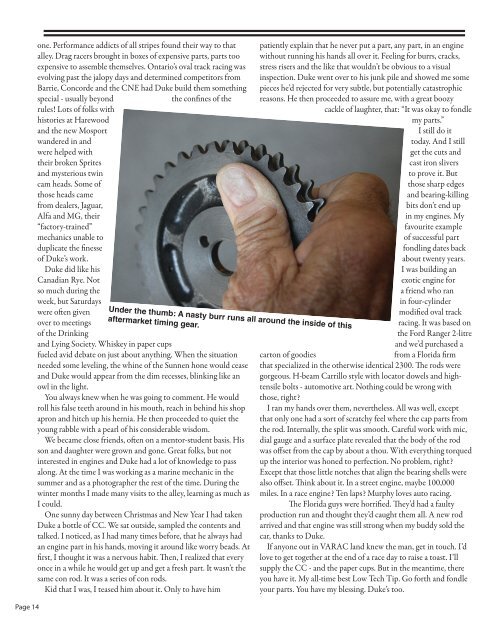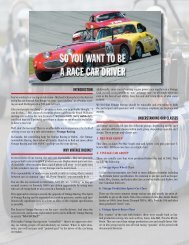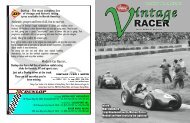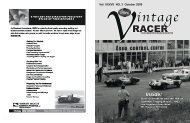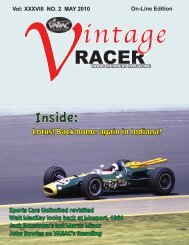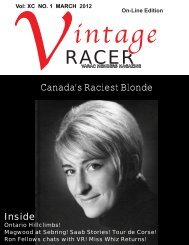Create successful ePaper yourself
Turn your PDF publications into a flip-book with our unique Google optimized e-Paper software.
Page 14<br />
one. Performance addicts of all stripes found their way to that<br />
alley. Drag racers brought in boxes of expensive parts, parts too<br />
expensive to assemble themselves. Ontario’s oval track racing was<br />
evolving 1928 past the CAR jalopy REPAIR days and determined MAILER... competitors from<br />
Barrie,<br />
AUTOMOTIVE<br />
Concorde and the CNE<br />
REPAIR<br />
had Duke<br />
ADVERTISEMENT<br />
build them something<br />
special - usually beyond the confi nes of the<br />
IN 1928...SENT ON A PENNY POSTCARD<br />
rules! Lots of folks with<br />
histories at Harewood<br />
and the new Mosport<br />
wandered in and<br />
were helped with<br />
their broken Sprites<br />
and mysterious twin<br />
cam heads. Some of<br />
those heads came<br />
from dealers, Jaguar,<br />
Alfa and MG, their<br />
“factory-trained”<br />
mechanics unable to<br />
duplicate the fi nesse<br />
of Duke’s work.<br />
Duke did like his<br />
Canadian Rye. Not<br />
so much during the<br />
week, but Saturdays<br />
were oft en given<br />
over to meetings<br />
of the Drinking<br />
and Lying Society. Whiskey in paper cups<br />
fueled avid debate on just about anything. When the situation<br />
needed some leveling, the whine of the Sunnen hone would cease<br />
and Duke would appear from the dim recesses, blinking like an<br />
owl in the light.<br />
You always knew when he was going to comment. He would<br />
roll his false teeth around in his mouth, reach in behind his shop<br />
apron and hitch up his hernia. He then proceeded to quiet the<br />
young rabble with a pearl of his considerable wisdom.<br />
We became close friends, oft en on a mentor-student basis. His<br />
son and daughter were grown and gone. Great folks, but not<br />
interested in engines and Duke had a lot of knowledge to pass<br />
along. At the time I was working as a marine mechanic in the<br />
summer and as a photographer the rest of the time. During the<br />
winter months I made many visits to the alley, learning as much as<br />
I could.<br />
One sunny day between Christmas and New Year I had taken<br />
Duke a bottle of CC. We sat outside, sampled the contents and<br />
talked. I noticed, as I had many times before, that he always had<br />
an engine part in his hands, moving it around like worry beads. At<br />
fi rst, I thought it was a nervous habit. Th en, I realized that every<br />
once in a while he would get up and get a fresh part. It wasn’t the<br />
same con rod. It was a series of con rods.<br />
Kid that I was, I teased him about it. Only to have him<br />
Under Under the the thumb: thumb: A A nasty nasty burr burr runs runs all all around around the the inside inside of of this this<br />
aftermarket aftermarket timing timing gear.<br />
gear.<br />
patiently explain that he never put a part, any part, in an engine<br />
without running his hands all over it. Feeling for burrs, cracks,<br />
stress risers and the like that wouldn’t be obvious to a visual<br />
inspection. Duke went over to his junk pile and showed me some<br />
pieces he’d rejected for very subtle, but potentially catastrophic<br />
reasons. He then proceeded to assure me, with a great boozy<br />
cackle of laughter, that: “It was okay to fondle<br />
my parts.”<br />
I still do it<br />
today. And I still<br />
get the cuts and<br />
cast iron slivers<br />
to prove it. But<br />
those sharp edges<br />
and bearing-killing<br />
bits don’t end up<br />
in my engines. My<br />
favourite example<br />
of successful part<br />
fondling dates back<br />
about twenty years.<br />
I was building an<br />
exotic engine for<br />
a friend who ran<br />
in four-cylinder<br />
modifi ed oval track<br />
racing. It was based on<br />
the Ford Ranger 2-litre<br />
and we’d purchased a<br />
carton of goodies from a Florida fi rm<br />
that specialized in the otherwise identical 2300. Th e rods were<br />
gorgeous. H-beam Carrillo style with locator dowels and hightensile<br />
bolts - automotive art. Nothing could be wrong with<br />
those, right?<br />
I ran my hands over them, nevertheless. All was well, except<br />
that only one had a sort of scratchy feel where the cap parts from<br />
the rod. Internally, the split was smooth. Careful work with mic,<br />
dial gauge and a surface plate revealed that the body of the rod<br />
was off set from the cap by about a thou. With everything torqued<br />
up the interior was honed to perfection. No problem, right?<br />
Except that those little notches that align the bearing shells were<br />
also off set. Th ink about it. In a street engine, maybe 100,000<br />
miles. In a race engine? Ten laps? Murphy loves auto racing.<br />
Th e Florida guys were horrifi ed. Th ey’d had a faulty<br />
production run and thought they’d caught them all. A new rod<br />
arrived and that engine was still strong when my buddy sold the<br />
car, thanks to Duke.<br />
If anyone out in VARAC land knew the man, get in touch. I’d<br />
love to get together at the end of a race day to raise a toast. I’ll<br />
supply the CC - and the paper cups. But in the meantime, there<br />
you have it. My all-time best Low Tech Tip. Go forth and fondle<br />
your parts. You have my blessing. Duke’s too.


